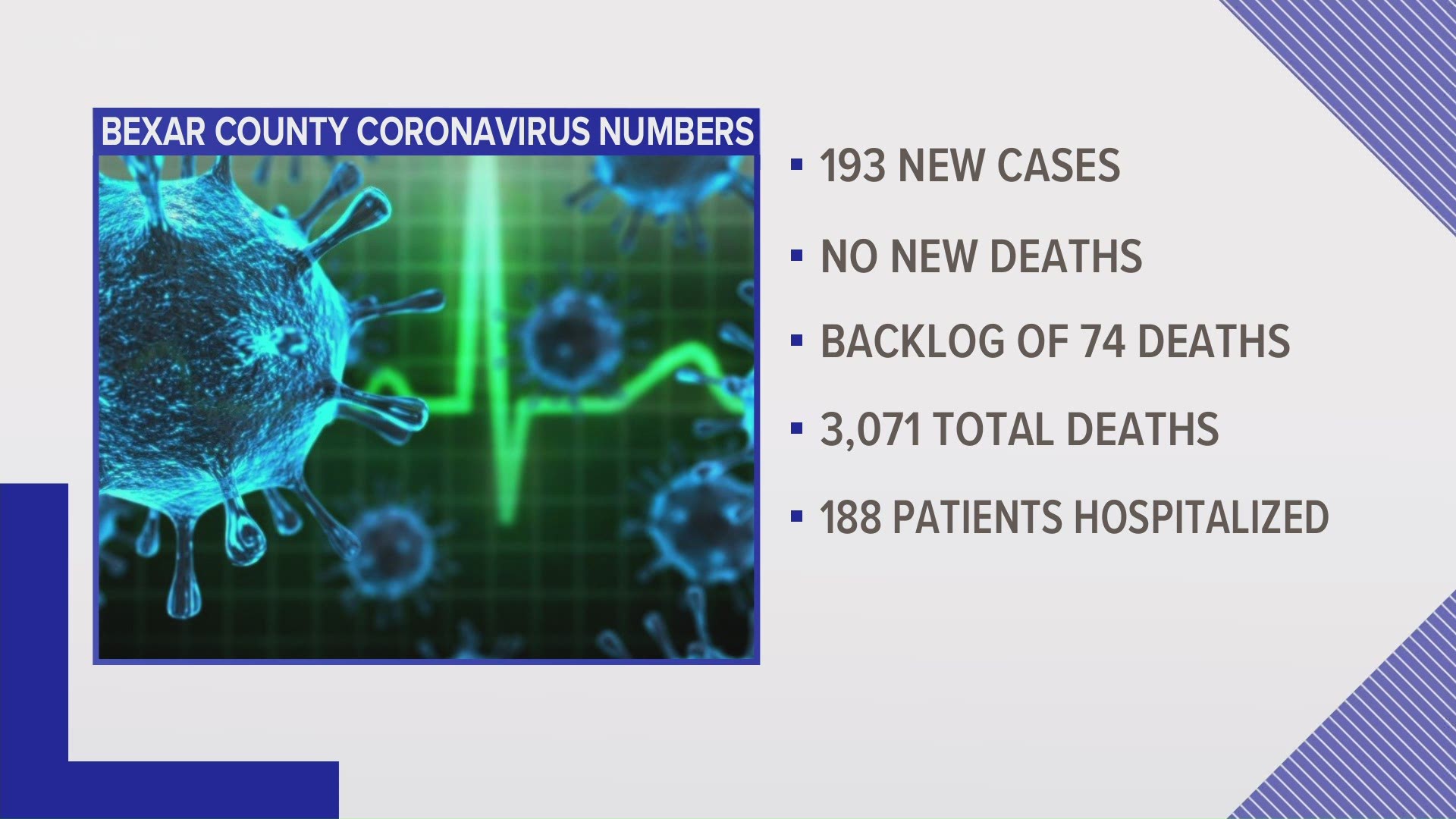SAN ANTONIO — We're tracking the latest numbers from the coronavirus pandemic in San Antonio and across Texas. Here are the latest numbers reported by Bexar and surrounding counties:
- Bexar County: On Sunday, 193 new cases were reported – along with 665 additional backlogged cases – bringing the total number of cases to 202,550. No new deaths were reported, but the county tallied 74 backlogged deaths, raising the local death toll from virus complications rose to 3,071.
- Hays County: On Friday, officials reported 21 new cases in the county and one additional COVID-related fatality. There is now a total of 16,877 lab-confirmed local cases, while the death toll rose to 235. Officials estimate 16,221 residents have recovered, while 421 are still ill with the virus.
- Comal County: Officials reported 17 new cases on Friday, along with no additional virus-related deaths. As of Friday, 9,512 total COVID-19 cases have been reported, including 5,009 confirmed and 4,482 probable cases, while 303 county residents have died due to COVID-19 complications.
More county case information is available through the Texas Department of Health Services COVID-19 dashboard.
How Bexar County is trending
We've tracked how many coronavirus cases have been confirmed in Bexar County from the time officials began reporting cases in March 2020. The graphic below shows the number of cases since June and charts those daily case numbers along a 7-day moving average to provide a more accurate picture of the overall coronavirus case curve in our area and the direction we're trending amid the pandemic.
On Sunday, Metro Health updated its online coronavirus dashboards to reflect an additional 858 cases in Bexar County—193 new cases reported over the last two weeks, and 665 backlogged diagnoses. At least 202,550 county residents have been diagnosed with the virus, and the seven-day rolling case average now stands at 174.
Health authorities also reported 74 backlogged virus deaths which officials say occurred between Christmas and March 4. While no new virus-related fatalities were reported (as a reminder, "new" is categorized as having occurred in the last 14 days), that backlog brings the local death toll to 3,071.

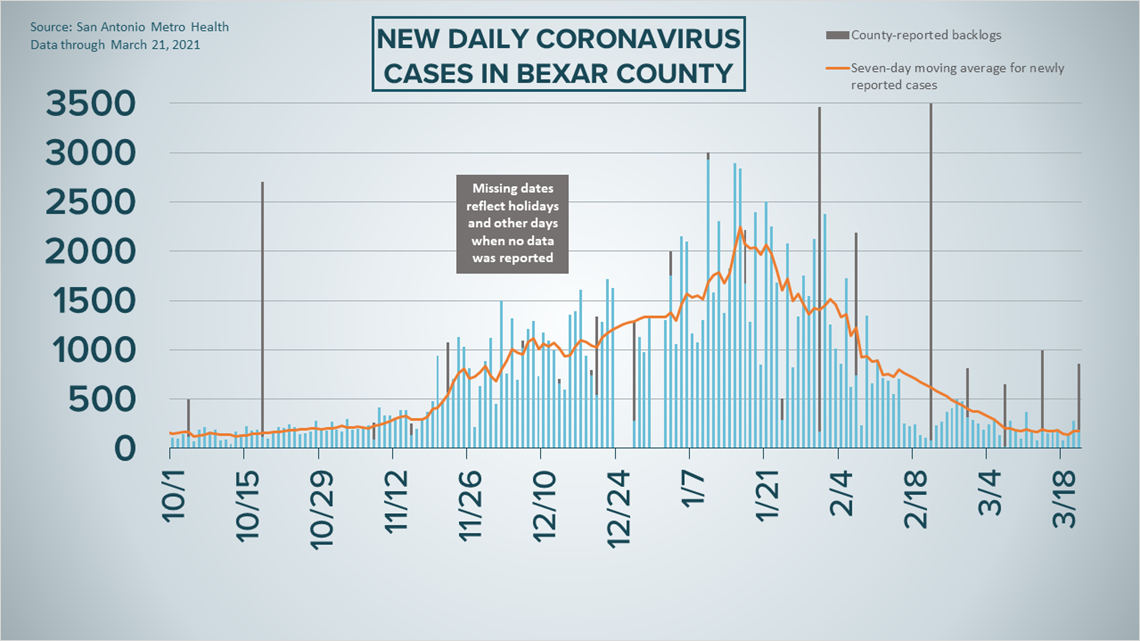
Hospitalizations continued to go down Sunday, with another slight drop. A total of 188 coronavirus patients were receiving treatment at local facilities, which is three fewer than Saturday.
The hospitalizations number hasn't been that low since mid-October.
Of those 188, 45 patients are on ventilators and 76 are in intensive care; those two numbers are up slightly from Saturday, despite the overall drop in hospitalized patients.

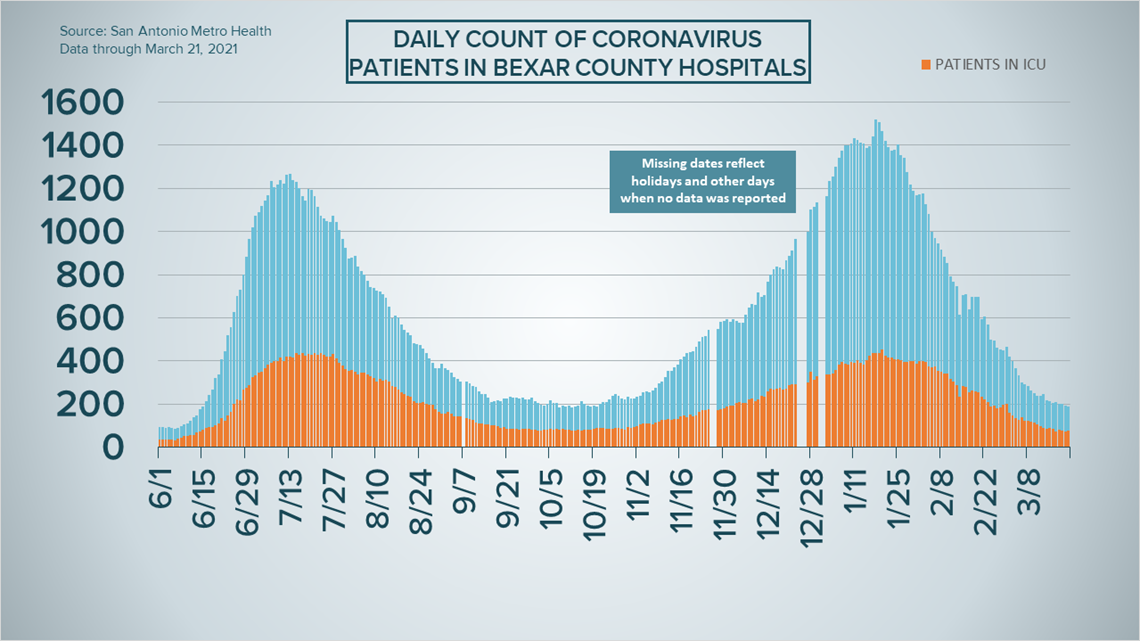
Coronavirus in Texas
The total number of novel coronavirus cases in the state since the pandemic began grew by 1,982 on Sunday, according to the Texas Department of State Health Services. That total includes 1,677 new confirmed cases, 228 new probable cases, and a backlog of 77 cases. More details can be found on this page.
Sunday's figures bring the total number of Texans diagnosed with COVID-19 to more than 2.745 million.

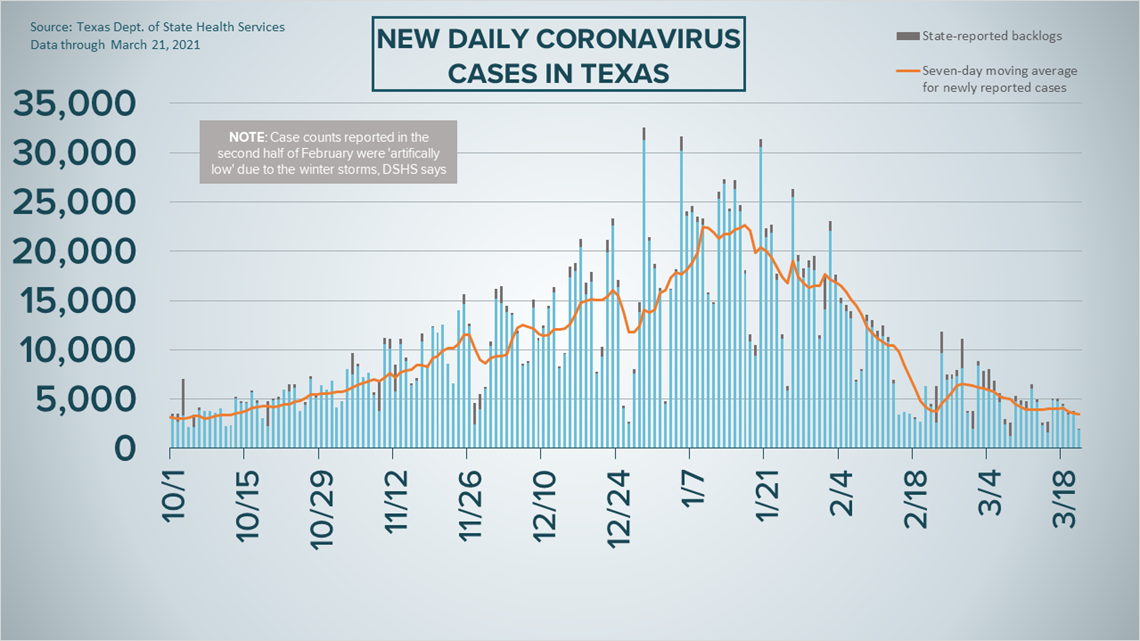
Meanwhile, state health authorities reported an additional 59 deaths from coronavirus complications in Texas. In all, 46,413 Texans have died from COVID-19 complications.
The number of concurrent hospitalizations across the state decreased for the twelfth day in a row, this time by 174 to 3,446 COVID-19 patients receiving treatment for their symptoms across the state, as of Sunday. The last time the figure was this low was Oct. 6.
The state, meanwhile, estimates that about 2.588 million Texans have recovered, while 106,471 Texans remain ill with COVID-19.
The latest update from the Texas Education Agency showed that there have been at least 194,936 cumulative cases among staff and students on Texas public school campuses through March 14. That number comprises 127,196 positive student cases and 67,740 staff cases. More information can be found here.

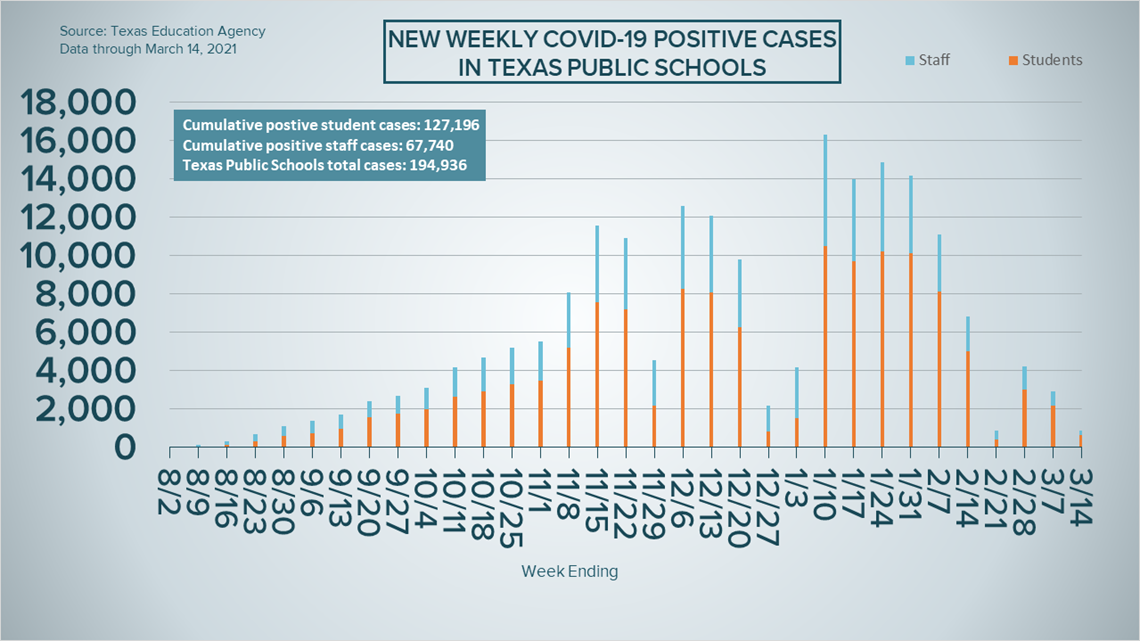
The TEA typically releases new data on school cases on Fridays.
Latest Coronavirus Headlines
- White House Easter Egg roll canceled again, official 2021 designs revealed
- Inside San Antonio's effort to vaccinate the homeless population
- A year into the pandemic, and veterans halls are struggling
- Third stimulus check update: Couples reporting only half payments
- March Madness: First team out due to COVID-19 protocols
- Half of UK adults have received first dose of COVID-19 vaccine
- WHO expert: Coronavirus origin study to have unanimity despite pressure
Coronavirus symptoms
The symptoms of coronavirus can be similar to the flu or a bad cold. Symptoms include fever or chills, cough, shortness of breath or difficulty breathing, fatigue, muscle or body aches, headache, new loss of taste or smell sore throat, congestion or runny nose, nausea or vomiting, and diarrhea, according to the Centers for Disease Control.
Most healthy people will have mild symptoms. A study of more than 72,000 patients by the Centers for Disease Control in China showed 80 percent of the cases there were mild.
But infections can cause pneumonia, severe acute respiratory syndrome, kidney failure, and even death, according to the World Health Organization. Older people with underlying health conditions are most at risk.
Experts determined there was consistent evidence these conditions increase a person's risk, regardless of age:
- Chronic kidney disease
- COPD (chronic obstructive pulmonary disease)
- Obesity (BMI of 30 or higher)
- Immunocompromised state (weakened immune system) from solid organ transplant
- Serious heart conditions, such as heart failure, coronary artery disease, or cardiomyopathies
- Sickle cell disease
- Type 2 diabetes
- The CDC believes symptoms may appear anywhere from two to 14 days after being exposed.
Human coronaviruses are usually spread...
- Between people who are in close contact with one another (within about 6 feet).
- Through respiratory droplets produced when an infected person coughs, sneezes or talks. These droplets can land in the mouths or noses of people who are nearby or possibly be inhaled into the lungs.
- Some recent studies have suggested that COVID-19 may be spread by people who are not showing symptoms.
Help stop the spread of coronavirus
- Stay home when you are sick.
- Eat and sleep separately from your family members
- Use different utensils and dishes
- Cover your cough or sneeze with your arm, not your hand.
- If you use a tissue, throw it in the trash.
Find a Testing Location
City officials recommend getting a COVID-19 test if you experience fever or chills, cough, shortness of breath or difficulty breathing, fatigue, muscle or body aches, headache, new loss of taste or smell, sore throat, congestion or runny nose, nausea or vomiting, or diarrhea.
Here's a Testing Sites Locator to help you find the testing location closest to you in San Antonio.

